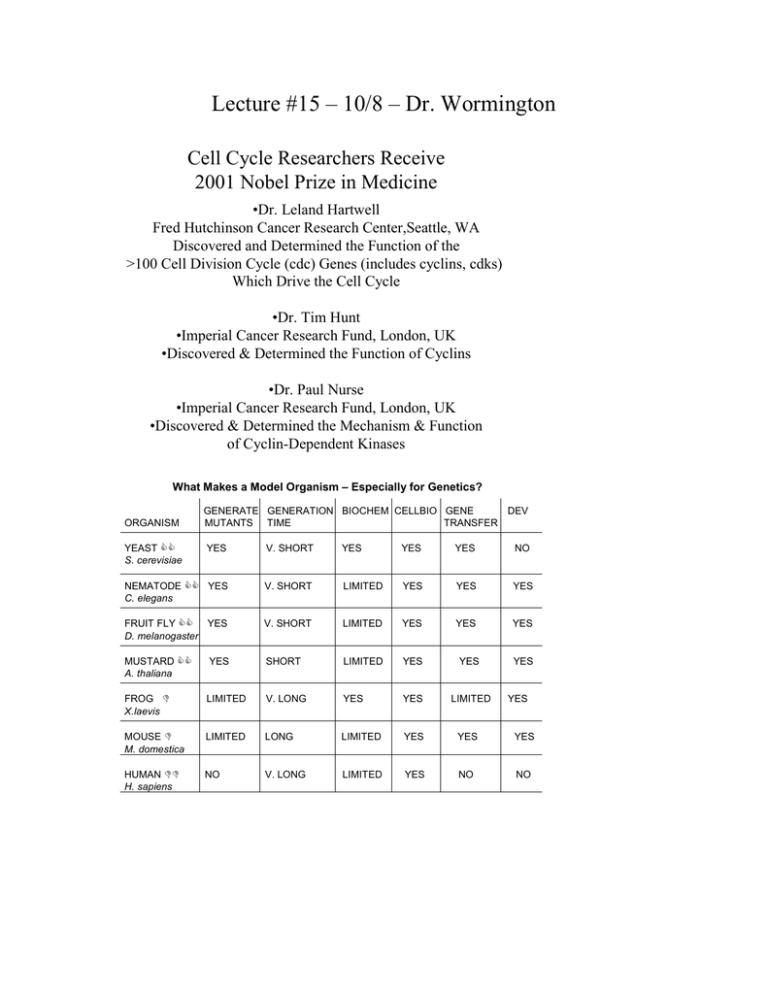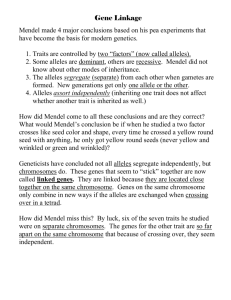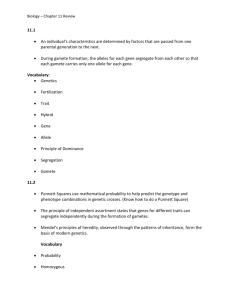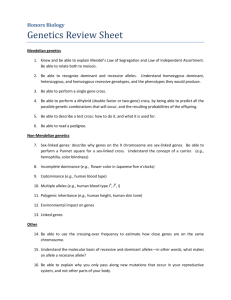Lecture #15 – 10/8 – Dr. Wormington Cell Cycle Researchers Receive
advertisement

Lecture #15 – 10/8 – Dr. Wormington Cell Cycle Researchers Receive 2001 Nobel Prize in Medicine •Dr. Leland Hartwell Fred Hutchinson Cancer Research Center,Seattle, WA Discovered and Determined the Function of the >100 Cell Division Cycle (cdc) Genes (includes cyclins, cdks) Which Drive the Cell Cycle •Dr. Tim Hunt •Imperial Cancer Research Fund, London, UK •Discovered & Determined the Function of Cyclins •Dr. Paul Nurse •Imperial Cancer Research Fund, London, UK •Discovered & Determined the Mechanism & Function of Cyclin-Dependent Kinases What Makes a Model Organism – Especially for Genetics? ORGANISM YEAST && S. cerevisiae GENERATE GENERATION BIOCHEM CELLBIO GENE DEV MUTANTS TIME TRANSFER YES V. SHORT YES YES YES NO NEMATODE && YES C. elegans V. SHORT LIMITED YES YES YES FRUIT FLY && YES D. melanogaster V. SHORT LIMITED YES YES YES MUSTARD && A. thaliana YES SHORT LIMITED YES YES FROG ' X.laevis LIMITED V. LONG YES YES LIMITED MOUSE ' M. domestica LIMITED LONG LIMITED YES YES YES HUMAN '' H. sapiens NO V. LONG LIMITED YES NO NO YES YES Mendel Experimentally Utilized Phenotypic Diversity, Large # of Progeny, Ease of Manipulation & Short Generation Time in Pisum sativum To Elucidate Principles of Inheritance & Establish Genetics as a Science 1st Use of a Model Experimental Organism Characters = Genes: Seed morphology, color; Flower color, Pod morphology etc. Traits = Alleles: Spherical vs wrinkled; Yellow vs green; Purple vs white; Infl. vs constr. etc. Mendel's 1st – The Monohybrid Cross Parental generation 1st filial generation F1 100% Spherical 2nd filial generation F2 75% Spherical 25% wrinkled Units of Inheritance Present as Discrete Particles = Gene Units Occur in Pairs = Alleles F1 Individuals are Heterozygous Ss Do not breed true Mendel's 1st law Law of Segregation Alleles Segregate Independently Each Gamete Receives 1 Allele Alleles Are Combined Randomly In Zygote "True-Breeding" Individuals Homozygous SS or ss Always exhibit same phenotype when “selfed” or “self-crossed” Dominant allele S appears in F1 Recessive allele s absent from F1 Phenotype = Trait e.g., Spherical vs wrinkled 3:1 Genotype = Genetic Constitution e.g., SS, Ss, ss 1 : 2 :1 Meiosis Explains Independent Segregation Of Alleles Locus = Chromosomal Location of the Seed gene S & s are the 2 alleles of this gene Homologous Chromosomes Separate in Meiosis I Alleles Segregate SS & ss Sister Chromatids Separate in Meiosis II Each Haploid Gamete Receives 1 allele S or s Test Cross aka Back Cross Distinguishes Between Homozygous and Heterozygous Genotypes for Dominant Phenotypes A recessive phenotype Can only arise from a Homozygous genotype Mendel's 2nd – The Dihybrid Cross Segregation of S from s is Independent from Segregation of Y from y F2 has 4 phenotypes: 2 Parental: Sphere/Yellow (9) Wrinkled/Green (1) + 2 Recombinant: Sphere/Green (3) Wrinkled/Yellow (3) F2 Ratio of 9:3:3:1 Mendel's 2nd law: Law of Independent Assortment Alleles of Different Genes *Almost always assort Independently of one another *Note: This applies To genes on Different Chromosomes but Not necessarily to genes On the Same chromosome Genes on the same Chromosome are linked And subject to Recombination in meiosis I Meiosis Explains Independent Assortment Of Alleles (On Different Chromosomes) – Caveat Emptor Chromosome w/ S or s allele Does not determine where Chromosome w/ Y or y allele goes Chromosome w/ Y or y allele Does not determine where Chromosome w/ S or s allele goes Non-homologous Chromsomes Behave Independently D. melanogaster – An Ideal Genetic System to Illustrate: • Genes on the Same Chromosome Are Physically Linked & May Not Sort Independently •Genes on Homologous Chromosomes Can Recombine During Meiosis I •Genetic Maps Can be Derived from Recombination Frequencies Heterozygous Dominant Homozygous Recessive Test Cross If Linkage Were Absolute i.e. B/b & Vg/vg "co-localized" to the same locus, then no Recombinant progeny would be observed as below This is not the outcome! Instead, one observes recombinant phenotypes 17% of time - Recall 50% expected if unlinked & 0% if Absolutely Linked Recombination between linked genes on homologous chromosomes during Meiosis I explains why they do not sort independently Recombination between a given pair of linked genes occurs at a consistent, reproducible frequency Distance Determines Recombination Frequency The further apart 2 linked genes are located, the greater the likelihood that a crossover event will occur between them. (up to a limit) Conversely, 2 genes which are located close together have a reduced likelihood that a crossover event will occur between them. Therefore, can use recombination frequencies to map relative positions of genes on a given chromosome









